600-cell
In geometry, the 600-cell is the convex regular 4-polytope (four-dimensional analogue of a Platonic solid) with Schläfli symbol {3,3,5}. It is also known as the C600, hexacosichoron[1] and hexacosihedroid.[2] It is also called a tetraplex (abbreviated from "tetrahedral complex") and a polytetrahedron, being bounded by tetrahedral cells.
| 600-cell | |
|---|---|
 Schlegel diagram, vertex-centered (vertices and edges) | |
| Type | Convex regular 4-polytope |
| Schläfli symbol | {3,3,5} |
| Coxeter diagram | |
| Cells | 600 (3.3.3) |
| Faces | 1200 {3} |
| Edges | 720 |
| Vertices | 120 |
| Vertex figure |  icosahedron |
| Petrie polygon | 30-gon |
| Coxeter group | H4, [3,3,5], order 14400 |
| Dual | 120-cell |
| Properties | convex, isogonal, isotoxal, isohedral |
| Uniform index | 35 |
The 600-cell's boundary is composed of 600 tetrahedral cells with 20 meeting at each vertex.[lower-alpha 1] Together they form 1200 triangular faces, 720 edges, and 120 vertices. It is the 4-dimensional analogue of the icosahedron, since it has five tetrahedra meeting at every edge, just as the icosahedron has five triangles meeting at every vertex. Its dual polytope is the 120-cell, with which it can form a compound.
Geometry
The 600-cell is the fifth in the sequence of 6 convex regular 4-polytopes (in order of size and complexity).[lower-alpha 2] It can be deconstructed into twenty-five overlapping instances of its immediate predecessor the 24-cell,[4] as the 24-cell can be deconstructed into three overlapping instances of its predecessor the tesseract (8-cell), and the 8-cell can be deconstructed into two overlapping instances of its predecessor the 16-cell.[5]
The reverse procedure to construct each of these from an instance of its predecessor preserves the radius of the predecessor, but generally produces a successor with a smaller edge length.[lower-alpha 3] The 24-cell's edge length equals its radius, but the 600-cell's edge length is ~0.618 times its radius. The 600-cell's radius and edge length are in the golden ratio.
Coordinates
The vertices of a 600-cell of unit radius centered at the origin of 4-space, with edges of length 1/φ ≈ 0.618 (where φ = 1 + √5/2 ≈ 1.618 is the golden ratio), can be given[6] as follows:
8 vertices obtained from
- (0, 0, 0, ±1)
by permuting coordinates, and 16 vertices of the form:
- (±1/2, ±1/2, ±1/2, ±1/2)
The remaining 96 vertices are obtained by taking even permutations of
- 1/2(±φ, ±1, ±1/φ, 0)
Note that the first 8 are the vertices of a 16-cell, the second 16 are the vertices of a tesseract, and those 24 vertices together are the vertices of a 24-cell. The remaining 96 vertices are the vertices of a snub 24-cell, which can be found by partitioning each of the 96 edges of another 24-cell (dual to the first) in the golden ratio in a consistent manner.[7]
When interpreted as quaternions, these are the unit icosians.
The 120 vertices can be seen as the vertices of 4 sets of 6 orthogonal equatorial pentagons which do not share any vertices.[lower-alpha 4]
Polyhedral sections
The mutual distances of the vertices, measured in degrees of arc on the circumscribed hypersphere, only have the values 36° = 𝜋/5, 60° = 𝜋/3, 72° = 2𝜋/5, 90° = 𝜋/2, 108° = 3𝜋/5, 120° = 2𝜋/3, 144° = 4𝜋/5, and 180° = 𝜋. Departing from an arbitrary vertex V one has at 36° and 144° the 12 vertices of an icosahedron, at 60° and 120° the 20 vertices of a dodecahedron, at 72° and 108° the 12 vertices of a larger icosahedron, at 90° the 30 vertices of an icosidodecahedron, and finally at 180° the antipodal vertex of V.[8] These can be seen in the H3 Coxeter plane projections with overlapping vertices colored.[9]
Great circle polygons
In the 24-cell, there are squares, hexagons and triangles that lie on great circles (in equatorial planes through four or six vertices).[lower-alpha 5] In the 600-cell there are twenty-five overlapping inscribed 24-cells, with each square unique to one 24-cell, each hexagon or triangle shared by two 24-cells, and each vertex shared among five 24-cells.[lower-alpha 7]
In the 600-cell there are also great circle pentagons and decagons (in equatorial planes through ten vertices).[lower-alpha 8]
Only the decagon edges are visible elements of the 600-cell (because they are the edges of the 600-cell). The edges of the other great circle polygons are interior chords of the 600-cell, which are not shown in any of the 600-cell renderings in this article.
By symmetry, an equal number of polygons of each kind pass through each vertex; so it is possible to account for all 120 vertices as the intersection of a set of polygons of any one kind.
Vertex chords
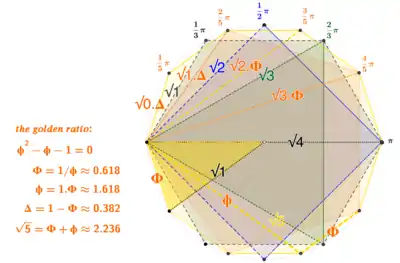
The 120 vertices are distributed[11] at eight different chord lengths from each other. These edges and chords of the 600-cell are simply the edges and chords of its five great circle polygons.[12] In ascending order of length, they are √0.𝚫, √1, √1.𝚫, √2, √2.𝚽, √3, √3.𝚽, and √4.[lower-alpha 12]
Notice that the four hypercubic chords of the 24-cell (√1, √2, √3, √4) alternate with the four new chords of the 600-cell's additional great circles, the decagons and pentagons. The new chord lengths are necessarily square roots of fractions, but very special fractions related to the golden ratio[lower-alpha 9] including the two golden sections of √5, as shown in the diagram.[lower-alpha 10]
Geodesics
The vertex chords of the 600-cell are arranged in geodesic great circle polygons of five kinds: decagons, hexagons, pentagons, squares, and triangles.[13]
The √0.𝚫 = 𝚽 edges form 72 flat regular central decagons, 6 of which cross at each vertex.[lower-alpha 1] Just as the icosidodecahedron can be partitioned into 6 central decagons (60 edges = 6 × 10), the 600-cell can be partitioned into 72 decagons (720 edges = 72 × 10). The 720 √0.𝚫 edges divide the surface into 1200 triangular faces and 600 tetrahedral cells: a 600-cell. The 720 edges occur in 360 parallel pairs, √3.𝚽 apart. As in the decagon and the icosidodecahedron, the edges occur in golden triangles[lower-alpha 14] which meet at the center of the polytope.[lower-alpha 11]
The √1 chords form 200 central hexagons (25 sets of 16, with each hexagon in two sets),[lower-alpha 6] 10 of which cross at each vertex (4 from each of five 24-cells, with each hexagon in two of the 24-cells). Each set of 16 hexagons consists of the 96 edges and 24 vertices of one of the 25 overlapping inscribed 24-cells. The √1 chords join vertices which are two √0.𝚫 edges apart. Each √1 chord is the long diameter of a face-bonded pair of tetrahedral cells (a triangular bipyramid), and passes through the center of the shared face. As there are 1200 faces, there are 1200 √1 chords, in 600 parallel pairs, √3 apart.
The √1.𝚫 chords form 144 central pentagons, 6 of which cross at each vertex.[lower-alpha 8] The √1.𝚫 chords run vertex-to-every-second-vertex in the same planes as the 72 decagons: two pentagons are inscribed in each decagon. The √1.𝚫 chords join vertices which are two √0.𝚫 edges apart on a geodesic great circle. The 720 √1.𝚫 chords occur in 360 parallel pairs, √2.𝚽 = φ apart.
The √2 chords form 450 central squares (25 disjoint sets of 18), 15 of which cross at each vertex (3 from each of five 24-cells). Each set of 18 squares consists of the 72 √2 chords and 24 vertices of one of the 25 overlapping inscribed 24-cells. The √2 chords join vertices which are three √0.𝚫 edges apart (and two √1 chords apart). Each √2 chord is the long diameter of an octahedral cell in just one 24-cell. There are 1800 √2 chords, in 900 parallel pairs, √2 apart.
The √2.𝚽 = φ chords form the legs of 720 central isosceles triangles (72 sets of 10 inscribed in each decagon), 6 of which cross at each vertex. The third edge (base) of each isosceles triangle is of length √3.𝚽. The √2.𝚽 chords run vertex-to-every-third-vertex in the same planes as the 72 decagons, joining vertices which are three √0.𝚫 edges apart on a geodesic great circle. There are 720 distinct √2.𝚽 chords, in 360 parallel pairs, √1.𝚫 apart.
The √3 chords form 400 equilateral central triangles (25 sets of 32, with each triangle in two sets), 20 of which cross at each vertex (4 from each of five 24-cells). Each set of 32 triangles consists of the 96 √3 chords and 24 vertices of one of the 25 overlapping inscribed 24-cells. The √3 chords run vertex-to-every-other-vertex in the same planes as the 200 hexagons: two triangles are inscribed in each hexagon. The √3 chords join vertices which are four √0.𝚫 edges apart (and two √1 chords apart on a geodesic great circle). Each √3 chord is the long diameter of two cubic cells in the same 24-cell.[lower-alpha 15] There are 1200 √3 chords, in 600 parallel pairs, √1 apart.
The √3.𝚽 chords (the diagonals of the pentagons) form the legs of 720 central isosceles triangles (144 sets of 5 inscribed in each pentagon), 6 of which cross at each vertex. The third edge (base) of each isosceles triangle is an edge of the pentagon of length √1.𝚫, so these are golden triangles.[lower-alpha 14] The √3.𝚽 chords run vertex-to-every-fourth-vertex in the same planes as the 72 decagons, joining vertices which are four √0.𝚫 edges apart on a geodesic great circle. There are 720 distinct √3.𝚽 chords, in 360 parallel pairs, √0.𝚫 apart.
The √4 chords occur as 60 long diameters (75 sets of 4 orthogonal axes), the 120 long radii of the 600-cell. The √4 chords join opposite vertices which are five √0.𝚫 edges apart on a geodesic great circle. There are 25 distinct but overlapping sets of 12 diameters, each comprising one of the 25 inscribed 24-cells.[lower-alpha 16]
The sum of the squared lengths[lower-alpha 17] of all these distinct chords of the 600-cell is 14,400 = 1202.[lower-alpha 18]
Boundary envelopes
The 600-cell rounds out the 24-cell by adding 96 more vertices between the 24-cell's existing 24 vertices, in effect adding twenty-four more overlapping 24-cells inscribed in the 600-cell.[lower-alpha 19] The new surface thus formed is a tessellation of smaller, more numerous cells[lower-alpha 20] and faces: tetrahedra of edge length 1/φ ≈ 0.618 instead of octahedra of edge length 1. It encloses the √1 edges of the 24-cells, which become interior chords in the 600-cell, like the √2 and √3 chords.
Since the tetrahedra are made of shorter triangle edges than the octahedra (by a factor of 1/φ, the inverse golden ratio), the 600-cell does not have unit edge-length in a unit-radius coordinate system the way the 24-cell and the tesseract do; unlike those two, the 600-cell is not radially equilateral. Like them it is radially triangular in a special way, but one in which golden triangles rather than equilateral triangles meet at the center.[lower-alpha 11]
The boundary envelope of 600 small tetrahedral cells wraps around the twenty-five envelopes of 24 octahedral cells (adding some 4-dimensional space in places between these 3-dimensional envelopes). The shape of those interstices must be an octahedral 4-pyramid of some kind, but in the 600-cell it is not regular.[lower-alpha 21]
Constructions
The 600-cell incorporates the geometries of every convex regular polytope in the first four dimensions, except the 5-cell, the 120-cell, and the polygons {7} and above.[16] Consequently, there are numerous ways to construct or deconstruct the 600-cell, but none of them are trivial. The construction of the 600-cell from its regular predecessor the 24-cell can be difficult to visualize.
Gosset's construction
Thorold Gosset discovered the semiregular 4-polytopes, including the snub 24-cell with 96 vertices, which falls between the 24-cell and the 600-cell in the sequence of convex 4-polytopes of increasing size and complexity in the same radius. Gosset's construction of the 600-cell from the 24-cell is in two steps, using the snub 24-cell as an intermediate form. In the first, more complex step (described elsewhere) the snub 24-cell is constructed by a special snub truncation of a 24-cell at the golden sections of its edges.[7] In the second step the 600-cell is constructed in a straightforward manner by adding 4-pyramids (vertices) to facets of the snub 24-cell.[17]
The snub 24-cell is a diminished 600-cell from which 24 vertices (and the cluster of 20 tetrahedral cells around each) have been truncated, leaving a "flat" icosahedral cell in place of each removed icosahedral pyramid.[lower-alpha 1] The snub 24-cell thus has 24 icosahedral cells and the remaining 120 tetrahedral cells. The second step of Gosset's construction of the 600-cell is simply the reverse of this diminishing: an icosahedral pyramid of 20 tetrahedral cells is placed on each icosahedral cell.
Constructing the unit-radius 600-cell from its precursor the unit-radius 24-cell by Gosset's method actually requires three steps. The 24-cell precursor to the snub-24 cell is not of the same radius: it is larger, since the snub-24 cell is its truncation. Starting with the unit-radius 24-cell, the first step is to reciprocate it around its midsphere to construct its outer canonical dual: a larger 24-cell, since the 24-cell is self-dual. That larger 24-cell can then be snub truncated into a unit-radius snub 24-cell.
Cell clusters
Since it is so indirect, Gosset's construction may not help us very much to directly visualize how the 600 tetrahedral cells fit together into a 3-dimensional surface envelope,[lower-alpha 20] or how they lie on the underlying surface envelope of the 24-cell's octahedral cells. For that it is helpful to build up the 600-cell directly from clusters of tetrahedral cells.
Most of us have difficulty visualizing the 600-cell from the outside in 4-space, or recognizing an outside view of the 600-cell due to our total lack of sensory experience in 4-dimensional spaces, but we should be able to visualize the surface envelope of 600 cells from the inside because that volume is a 3-dimensional space that we could actually "walk around in" and explore.[18] In this exercise of building the 600-cell up from cell clusters, we are entirely within a 3-dimensional space, albeit a strangely small, closed curved one, in which we can go a mere ten edge lengths away in a straight line in any direction and return to our starting point.
Icosahedra


The vertex figure of the 600-cell is the icosahedron.[lower-alpha 1] Twenty tetrahedral cells meet at each vertex, forming an icosahedral pyramid whose apex is the vertex, surrounded by its base icosahedron. The 600-cell has a dihedral angle of 𝜋/3 + arccos(−1/4) ≈ 164.4775°.[20]
An entire 600-cell can be assembled from 24 such icosahedral pyramids (bonded face-to-face at 8 of the 20 faces of the icosahedron, colored yellow in the illustration), plus 24 clusters of 5 tetrahedral cells (four cells face-bonded around one) which fill the voids remaining between the icosahedra. Six clusters of 5 cells surround each icosahedron, and six icosahedra surround each cluster of 5 cells. Five tetrahedral cells surround each icosahedron edge: two from the icosahedral pyramid, and three from a cluster of 5 cells (one of which is the central tetrahedron of the five). Each icosahedron is face-bonded to each adjacent cluster of 5 cells by two blue faces that share an edge (which is also one of the six edges of the central tetrahedron of the five).
The apexes of the 24 icosahedral pyramids are the vertices of a 24-cell inscribed in the 600-cell. The other 96 vertices (the vertices of the icosahedra) are the vertices of an inscribed snub 24-cell, which has exactly the same structure of icosahedra and tetrahedra described here, except that the icosahedra are not 4-pyramids filled by tetrahedral cells; they are only "flat" 3-dimensional icosahedral cells.
The partitioning of the 600-cell into clusters of 20 cells and clusters of 5 cells is artificial, since all the cells are the same. One can begin by picking out an icosahedral pyramid cluster centered at any arbitrarily chosen vertex. Thus there are 120 overlapping icosahedra in the 600-cell.
Coloring the icosahedra with 8 yellow and 12 blue faces can be done in 5 distinct ways.[lower-alpha 23] Thus each icosahedral pyramid's apex vertex is a vertex of 5 distinct 24-cells, and the 120 vertices comprise 25 (not 5) 24-cells.[lower-alpha 19]
The icosahedra are face-bonded into geodesic "straight lines" by their opposite faces, bent in the fourth dimension into a ring of 6 icosahedral pyramids. Their apexes are the vertices of a great circle hexagon. This hexagonal geodesic traverses a ring of 12 tetrahedral cells, alternately bonded face-to-face and vertex-to-vertex. The long diameter of each face-bonded pair of tetrahedra (each triangular bipyramid) is a hexagon edge (a 24-cell edge).
The tetrahedral cells are face-bonded into helices, bent in the fourth dimension into rings of 30 tetrahedral cells.[lower-alpha 24] Their edges form geodesic "straight lines" of 10 edges: great circle decagons. Each tetrahedron, having six edges, participates in six different decagons.
Octahedra
There is another useful way to partition the 600-cell surface, into 24 clusters of 25 tetrahedral cells, which reveals more structure[21] and a direct construction of the 600-cell from its predecessor the 24-cell.
Begin with any one of the clusters of 5 cells (above), and consider its central cell to be the center object of a new larger cluster of tetrahedral cells. The central cell is the first section of the 600-cell beginning with a cell. By surrounding it with more tetrahedral cells, we can reach the deeper sections beginning with a cell.
First, note that a cluster of 5 cells consists of 4 overlapping pairs of face-bonded tetrahedra (triangular dipyramids) whose long diameter is a 24-cell edge (a hexagon edge) of length √1. Six more triangular dipyramids fit into the concavities on the surface of the cluster of 5,[lower-alpha 25] so the exterior chords connecting its 4 apical vertices are also 24-cell edges of length √1. They form a tetrahedron of edge length √1, which is the second section of the 600-cell beginning with a cell.[lower-alpha 26] There are 600 of these √1 tetrahedral sections in the 600-cell.[lower-alpha 27]
With the six triangular dipyamids fit into the concavities, there are 12 new cells and 6 new vertices in addition to the 5 cells and 8 vertices of the original cluster. The 6 new vertices form the third section of the 600-cell beginning with a cell, an octahedron of edge length √1, obviously the cell of a 24-cell. As partially filled so far (by 17 tetrahedral cells), this √1 octahedron has concave faces into which a short triangular pyramid fits; it has the same volume as a regular tetrahedral cell but an irregular tetrahedral shape.[lower-alpha 28] Each octahedral cell consists of 1 + 4 + 12 + 8 = 25 tetrahedral cells: 17 regular tetrahedral cells plus 8 volumetrically equivalent tetrahedral cells each consisting of 6 one-sixth fragments from 6 different regular tetrahedral cells that each span three adjacent octahedral cells.
Thus the unit-radius 600-cell is constructed directly from its predecessor,[lower-alpha 21] the unit-radius 24-cell, by placing on each of its octahedral facets a truncated[lower-alpha 29] irregular octahedral pyramid of 14 vertices[lower-alpha 30] constructed (in the above manner) from 25 regular tetrahedral cells of edge length 1/φ ≈ 0.618.
Rotations
The 600-cell is generated by rotations of the 24-cell in increments of 36° = 𝜋/5 (the arc of one 600-cell edge length).
There are 25 inscribed 24-cells in the 600-cell. Therefore there are also 25 inscribed snub 24-cells, 75 inscribed tesseracts and 75 inscribed 16-cells.[lower-alpha 19]
The 8-vertex 16-cell has 4 long diameters inclined at 90° = 𝜋/2 to each other, often taken as the 4 orthogonal axes of the coordinate system.
The 24-vertex 24-cell has 12 long diameters inclined at 60° = 𝜋/3 to each other: 3 disjoint sets of 4 orthogonal axes, each set comprising the diameters of one of 3 inscribed 16-cells, isoclinically rotated by 𝜋/3 with respect to each other.
The 120-vertex 600-cell has 60 long diameters: not just 5 disjoint sets of 12 diameters, each comprising one of 5 inscribed 24-cells (as we might suspect by analogy), but 25 distinct but overlapping sets of 12 diameters, each comprising one of 25 inscribed 24-cells. There are 5 disjoint 24-cells in the 600-cell, but not just 5: there are 10 different ways to partition the 600-cell into 5 disjoint 24-cells.[lower-alpha 16]
The 24-cells are rotated with respect to each other in increments of 𝜋/5. The rotational distance between inscribed 24-cells is always a double rotation of between 0 and 4 increments of 𝜋/5 in one invariant plane, combined with 0 to 4 increments of 𝜋/5 in the orthogonal invariant plane, where the invariant planes are any two orthogonal central decagons. The product of these two 5-click simple rotations produces 25 distinct ways we can pick the 24 vertices of a 24-cell out of the 120 vertices of a 600-cell. Any five 24-cells which can be reached by either 5-click simple rotation by itself have disjoint vertices.
We can give the 25 24-cells physical addresses of the form (i, j) corresponding to their inclination from an origin 24-cell,[lower-alpha 31] where i and j are integers between 0 and 4 corresponding to multiples of 𝜋/5 in the two orthogonal planes.[lower-alpha 32] The 25 overlapping 24-cells are thus arranged logically by address (not physically) in a 5 x 5 array.[lower-alpha 33] The five 24-cells in each row of this array (any five 24-cells with the same i) are disjoint: they have disjoint sets of vertices that together account for all 120 vertices of the 600-cell. The five 24-cells in each column of the array (any five with the same j) are similarly disjoint. No other set of five 24-cells is disjoint; these are the only ten ways to partition the 25 24-cells into five disjoint 24-cells.
Radial golden triangles
The 600-cell can be constructed radially from 720 golden triangles of edge lengths √0.𝚫 √1 √1 which meet at the center of the 4-polytope, each contributing two √1 radii and a √0.𝚫 edge.[lower-alpha 11] They form 1200 triangular pyramids with their apexes at the center: irregular tetrahedra with equilateral √0.𝚫 bases (the faces of the 600-cell). These form 600 tetrahedral pyramids with their apexes at the center: irregular 5-cells with regular √0.𝚫 tetrahedron bases (the cells of the 600-cell).
As a configuration
This configuration matrix[23] represents the 600-cell. The rows and columns correspond to vertices, edges, faces, and cells. The diagonal numbers say how many of each element occur in the whole 600-cell. The non-diagonal numbers say how many of the column's element occur in or at the row's element.
Here is the configuration expanded with k-face elements and k-figures. The diagonal element counts are the ratio of the full Coxeter group order, 14400, divided by the order of the subgroup with mirror removal.
| H4 | k-face | fk | f0 | f1 | f2 | f3 | k-fig | Notes | |
|---|---|---|---|---|---|---|---|---|---|
| H3 | ( ) | f0 | 120 | 12 | 30 | 20 | {3,5} | H4/H3 = 14400/120 = 120 | |
| A1H2 | { } | f1 | 2 | 720 | 5 | 5 | {5} | H4/H2A1 = 14400/10/2 = 720 | |
| A2A1 | {3} | f2 | 3 | 3 | 1200 | 2 | { } | H4/A2A1 = 14400/6/2 = 1200 | |
| A3 | {3,3} | f3 | 4 | 6 | 4 | 600 | ( ) | H4/A3 = 14400/24 = 600 |
Symmetries
The icosians are a specific set of Hamiltonian quaternions with the same symmetry as the 600-cell.[24] The icosians lie in the golden field, (a + b√5) + (c + d√5)i + (e + f√5)j + (g + h√5)k, where the eight variables are rational numbers.[25] The finite sums of the 120 unit icosians are called the icosian ring.
When interpreted as quaternions, the 120 vertices of the 600-cell form a group under quaternionic multiplication. This group is often called the binary icosahedral group and denoted by 2I as it is the double cover of the ordinary icosahedral group I. It occurs twice in the rotational symmetry group RSG of the 600-cell as an invariant subgroup, namely as the subgroup 2IL of quaternion left-multiplications and as the subgroup 2IR of quaternion right-multiplications. Each rotational symmetry of the 600-cell is generated by specific elements of 2IL and 2IR; the pair of opposite elements generate the same element of RSG. The centre of RSG consists of the non-rotation Id and the central inversion −Id. We have the isomorphism RSG ≅ (2IL × 2IR) / {Id, -Id}. The order of RSG equals 120 × 120/2 = 7200.
The binary icosahedral group is isomorphic to SL(2,5).
The full symmetry group of the 600-cell is the Weyl group of H4. This is a group of order 14400. It consists of 7200 rotations and 7200 rotation-reflections. The rotations form an invariant subgroup of the full symmetry group. The rotational symmetry group was described by S.L. van Oss (1899); see References.
Visualization
The symmetries of the 3-D surface of the 600-cell are somewhat difficult to visualize due to both the large number of tetrahedral cells,[lower-alpha 20] and the fact that the tetrahedron has no opposing faces or vertices. One can start by realizing the 600-cell is the dual of the 120-cell. One may also notice that the 600-cell also contains the vertices of a dodecahedron,[16] which with some effort can be seen in most of the below perspective projections.
Union of two tori
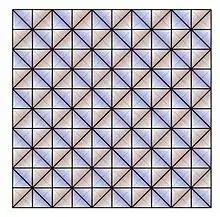
The 120-cell can be decomposed into two disjoint tori. Since it is the dual of the 600-cell, this same dual tori structure exists in the 600-cell, although it is somewhat more complex. The 10-cell geodesic path in the 120-cell corresponds to a 10-vertex decagon path in the 600-cell. Start by assembling five tetrahedra around a common edge. This structure looks somewhat like an angular "flying saucer". Stack ten of these, vertex to vertex, "pancake" style. Fill in the annular ring between each "saucer" with 10 tetrahedra forming an icosahedron. You can view this as five, vertex stacked, icosahedral pyramids, with the five extra annular ring gaps also filled in. The surface is the same as that of ten stacked pentagonal antiprisms. You now have a torus consisting of 150 cells, ten edges long, with 100 exposed triangular faces, 150 exposed edges, and 50 exposed vertices. Stack another tetrahedron on each exposed face. This will give you a somewhat bumpy torus of 250 cells with 50 raised vertices, 50 valley vertices, and 100 valley edges. The valleys are 10 edge long closed paths and correspond to other instances of the 10-vertex decagon path mentioned above. These paths spiral around the center core path, but mathematically they are all equivalent. Build a second identical torus of 250 cells that interlinks with the first. This accounts for 500 cells. These two tori mate together with the valley vertices touching the raised vertices, leaving 100 tetrahedral voids that are filled with the remaining 100 tetrahedra that mate at the valley edges. This latter set of 100 tetrahedra are on the exact boundary of the duocylinder and form a clifford torus. They can be "unrolled" into a square 10x10 array. Incidentally this structure forms one tetrahedral layer in the tetrahedral-octahedral honeycomb.
 A single 30-tetrahedron ring Boerdijk–Coxeter helix within the 600-cell, seen stereographic projection |
 A 30-tetrahedron ring can be seen along the perimeter of this 30-gonal orthogonal projection |
There are exactly 50 "egg crate" recesses and peaks on both sides that mate with the 250 cell tori. In this case into each recess, instead of an octahedron as in the honeycomb, fits a triangular bipyramid composed of two tetrahedra.
The 600-cell can be further partitioned into 20 disjoint intertwining rings of 30 cells and ten edges long each, forming a discrete Hopf fibration. These chains of 30 tetrahedra each form a Boerdijk–Coxeter helix. Five such helices nest and spiral around each of the 10-vertex decagon paths, forming the initial 150 cell torus mentioned above.
This decomposition of the 600-cell has symmetry [[10,2+,10]], order 400, the same symmetry as the grand antiprism. The grand antiprism is just the 600-cell with the two above 150-cell tori removed, leaving only the single middle layer of tetrahedra, similar to the belt of an icosahedron with the 5 top and 5 bottom triangles removed (pentagonal antiprism).
Images
2D projections
The H3 decagonal projection shows the plane of the van Oss polygon.
| H4 | - | F4 |
|---|---|---|
 [30] |
 [20] |
 [12] |
| H3 | A2 / B3 / D4 | A3 / B2 |
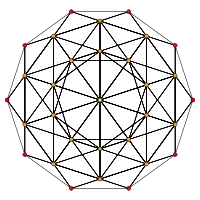 [10] |
 [6] |
 [4] |
3D projections
A three-dimensional model of the 600-cell, in the collection of the Institut Henri Poincaré, was photographed in 1934–1935 by Man Ray, and formed part of two of his later "Shakesperean Equation" paintings.[26]
| Vertex-first projection | |
|---|---|
 |
This image shows a vertex-first perspective projection of the 600-cell into 3D. The 600-cell is scaled to a vertex-center radius of 1, and the 4D viewpoint is placed 5 units away. Then the following enhancements are applied:
|
| Cell-first projection. | |
 |
This image shows the 600-cell in cell-first perspective projection into 3D. Again, the 600-cell to a vertex-center radius of 1 and the 4D viewpoint is placed 5 units away. The following enhancements are then applied:
This particular viewpoint shows a nice outline of 5 tetrahedra sharing an edge, towards the front of the 3D image. |
| Simple Rotation | |
 |
A 3D projection of a 600-cell performing a simple rotation. |
| Concentric Hulls | |
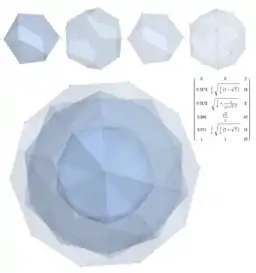 |
The 600-cell is projected to 3D using an orthonormal basis. The vertices are sorted and tallied by their 3D norm. Generating the increasingly transparent hull of each set of tallied norms shows pairs of: 1) points at the origin |
Frame synchronized animated comparison of the 600 cell using orthogonal isometric (left) and perspective (right) projections.
| Stereographic projection (on 3-sphere) | |
|---|---|
 |
Cell-Centered. The 720 edges of the 600-cell can be seen here as 72 circles, each divided into 10 arc-edges at the intersections. Each vertex has 6 circles intersecting. |
Diminished 600-cells
The snub 24-cell may be obtained from the 600-cell by removing the vertices of an inscribed 24-cell and taking the convex hull of the remaining vertices. This process is a diminishing of the 600-cell.
The grand antiprism may be obtained by another diminishing of the 600-cell: removing 20 vertices that lie on two mutually orthogonal rings and taking the convex hull of the remaining vertices.
A bi-24-diminished 600-cell, with all tridiminished icosahedron cells has 48 vertices removed, leaving 72 of 120 vertices of the 600-cell. The dual of a bi-24-diminished 600-cell, is a tri-24-diminished 600-cell, with 48 vertices and 72 hexahedron cells.
There are a total of 314,248,344 diminishings of the cell by non-adjacent vertices. All of these consist of regular tetrahedral and icosahedral cells.[27]
| Diminished 600-cells | |||||||||||
|---|---|---|---|---|---|---|---|---|---|---|---|
| Name | Tri-24-diminished 600-cell | Bi-24-diminished 600-cell | Snub 24-cell (24-diminished 600-cell) |
Grand antiprism (20-diminished 600-cell) |
600-cell | ||||||
| Vertices | 48 | 72 | 96 | 100 | 120 | ||||||
| Vertex figure (Symmetry) |
 dual of tridiminished icosahedron ([3], order 6) |
 tetragonal antiwedge ([2]+, order 2) |
 tridiminished icosahedron ([3], order 6) |
 bidiminished icosahedron ([2], order 4) |
 Icosahedron ([5,3], order 120) | ||||||
| Symmetry | Order 144 (48×3 or 72×2) | [3+,4,3] Order 576 (96×6) |
[[10,2+,10]] Order 400 (100×4) |
[5,3,3] Order 14400 (120×120) | |||||||
| Net |  |
 |
 |
 |
 | ||||||
| Ortho H4 plane |
 |
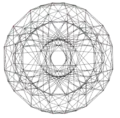 |
 |
 | |||||||
| Ortho F4 plane |
 |
 |
 |
 | |||||||
Related complex polygons
The regular complex polytopes 3{5}3, ![]()
![]()
![]() and 5{3}5,
and 5{3}5, ![]()
![]()
![]() , in have a real representation as 600-cell in 4-dimensional space. Both have 120 vertices, and 120 edges. The first has Complex reflection group 3[5]3, order 360, and the second has symmetry 5[3]5, order 600.[28]
, in have a real representation as 600-cell in 4-dimensional space. Both have 120 vertices, and 120 edges. The first has Complex reflection group 3[5]3, order 360, and the second has symmetry 5[3]5, order 600.[28]
| Regular complex polytope in orthogonal projection of H4 Coxeter plane | ||
|---|---|---|
 {3,3,5} Order 14400 |
 3{5}3 Order 360 |
 5{3}5 Order 600 |
Related polytopes and honeycombs
The 600-cell is one of 15 regular and uniform polytopes with the same symmetry [3,3,5]:
| H4 family polytopes | |||||||||||
|---|---|---|---|---|---|---|---|---|---|---|---|
| 120-cell | rectified 120-cell |
truncated 120-cell |
cantellated 120-cell |
runcinated 120-cell |
cantitruncated 120-cell |
runcitruncated 120-cell |
omnitruncated 120-cell | ||||
| {5,3,3} | r{5,3,3} | t{5,3,3} | rr{5,3,3} | t0,3{5,3,3} | tr{5,3,3} | t0,1,3{5,3,3} | t0,1,2,3{5,3,3} | ||||
 |
 |
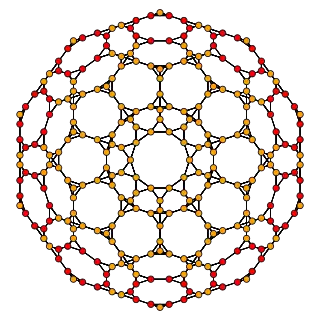 |
 |
 |
 |
 |
 | ||||
 |
 |
 |
 |
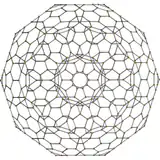 |
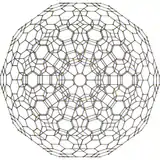 |
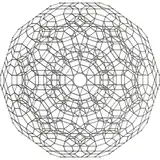 | |||||
| 600-cell | rectified 600-cell |
truncated 600-cell |
cantellated 600-cell |
bitruncated 600-cell |
cantitruncated 600-cell |
runcitruncated 600-cell |
omnitruncated 600-cell | ||||
| {3,3,5} | r{3,3,5} | t{3,3,5} | rr{3,3,5} | 2t{3,3,5} | tr{3,3,5} | t0,1,3{3,3,5} | t0,1,2,3{3,3,5} | ||||
It is similar to three regular 4-polytopes: the 5-cell {3,3,3}, 16-cell {3,3,4} of Euclidean 4-space, and the order-6 tetrahedral honeycomb {3,3,6} of hyperbolic space. All of these have a tetrahedral cells.
| {3,3,p} polytopes | |||||||||||
|---|---|---|---|---|---|---|---|---|---|---|---|
| Space | S3 | H3 | |||||||||
| Form | Finite | Paracompact | Noncompact | ||||||||
| Name | {3,3,3} |
{3,3,4} |
{3,3,5} |
{3,3,6} |
{3,3,7} |
{3,3,8} |
... {3,3,∞} | ||||
| Image |  |
 |
 |
 |
 |
 |
 | ||||
| Vertex figure |
 {3,3} |
 {3,4} |
 {3,5} |
 {3,6} |
 {3,7} |
 {3,8} |
 {3,∞} | ||||
This 4-polytope is a part of a sequence of 4-polytope and honeycombs with icosahedron vertex figures:
| {p,3,5} polytopes | |||||||
|---|---|---|---|---|---|---|---|
| Space | S3 | H3 | |||||
| Form | Finite | Compact | Paracompact | Noncompact | |||
| Name | {3,3,5} |
{4,3,5} |
{5,3,5} |
{6,3,5} |
{7,3,5} |
{8,3,5} |
... {∞,3,5} |
| Image |  |
 |
 |
 |
 |
 |
 |
| Cells | {3,3} |
{4,3} |
{5,3} |
{6,3} |
{7,3} |
{8,3} |
{∞,3} |
See also
- 24-cell, the predecessor 4-polytope on which the 600-cell is based
- 120-cell, the dual 4-polytope to the 600-cell, and its successor
- Uniform 4-polytope family with [5,3,3] symmetry
- Regular 4-polytope
- Polytope
Notes
- In the 3-dimensional space of the 600-cell's boundary surface, at each vertex one finds the twelve nearest other vertices surrounding the vertex the way an icosahedron's vertices surround its center. Twelve 600-cell edges converge at the icosahedron's center, where they appear to form six straight lines which cross there. However, the center is actually displaced in the 4th dimension (radially outward from the center of the 600-cell), out of the hyperplane defined by the icosahedron's vertices. Thus the vertex icosahedron is actually a canonical Icosahedral pyramid, composed of 20 regular tetrahedra on a regular icosahedron base.
- The convex regular 4-polytopes can be ordered by size as a measure of 4-dimensional content (hypervolume) for the same radius. Each greater polytope in the sequence is rounder than its predecessor, enclosing more content[3] within the same radius. The 4-simplex (5-cell) is the limit smallest case, and the 120-cell is the largest. Complexity (as measured by comparing configuration matrices or simply the number of vertices) follows the same ordering. This provides an alternative numerical naming scheme for regular polytopes in which the 600-cell is the 120-point 4-polytope: fifth in the ascending sequence that runs from 5-point 4-polytope to 600-point 4-polytope.
- The edge length will always be different unless predecessor and successor are both radially equilateral, i.e. their edge length is the same as their radius (so both are preserved). Since radially equilateral polytopes are rare, the only such construction (in any dimension) is from the 8-cell to the 24-cell.
- The 6 orthogonal pentagons in each set share no vertices because in 4 dimensions orthogonal planes through a central point intersect at no other points, only that common center. Two pentagons in different orthogonal sets are not orthogonal so they share a common diameter of the 600-cell, but no vertices because pentagons do not have opposing vertices. (To ensure that the non-orthogonal pentagons cross each other without sharing a vertex, the 4 sets must be chosen appropriately; the 600-cell has 75 sets of 6 orthogonal planes, three sets defining each 24-cell.)
- The 600-cell geometry is based on the 24-cell. The 600-cell rounds out the 24-cell with 2 more great circle polygons (exterior decagon and interior pentagon), adding 4 more chord lengths which alternate with the 24-cell's 4 chord lengths.
 Vertex geometry of the radially equilateral 24-cell, showing the 3 great circle polygons and the 4 vertex-to-vertex chord lengths.
Vertex geometry of the radially equilateral 24-cell, showing the 3 great circle polygons and the 4 vertex-to-vertex chord lengths. - A 24-cell contains 16 hexagons. In the 600-cell, with 25 24-cells, each 24-cell is disjoint from 8 24-cells and intersects each of the other 16 24-cells in six vertices that form a hexagon.[10] A 600-cell contains 25・16/2 = 200 such hexagons.
- In cases where inscribed 4-polytopes of the same kind occupy disjoint sets of vertices (such as the two 16-cells inscribed in the tesseract, or the three 16-cells inscribed in the 24-cell), their sets of vertex chords and central polygons must likewise be disjoint. In the cases where they share vertices (such as the three tesseracts inscribed in the 24-cell, or the 25 24-cells inscribed in the 600-cell), they may also share some vertex chords and central polygons.[lower-alpha 6]
- Each of the 25 24-cells of the 600-cell contains exactly one vertex (or no vertices) of each regular pentagon.[10]
- The fractional-root golden chords exemplify that the golden ratio ϕ is a circle ratio related to 𝜋:
- 𝜋/5 = arccos (ϕ/2)
- ϕ = 1 – 2 cos (3𝜋/5)
- The 600-cell edges are decagon edges of length √0.𝚫, which is 𝚽, the smaller golden section of √5; the edges are in the inverse golden ratio 1/φ to the √1 hexagon chords (the 24-cell edges). The other fractional-root chords exhibit golden relationships as well. The chord of length √1.𝚫 is a pentagon edge. The next fractional-root chord is a decagon diagonal of length √2.𝚽 which is φ, the larger golden section of √5; it is in the golden ratio[lower-alpha 9] to the √1 chord (and the radius).[lower-alpha 13] The last fractional-root chord is the pentagon diagonal of length √3.𝚽. The diagonal of a regular pentagon is always in the golden ratio to its edge, and indeed φ√1.𝚫 is √3.𝚽.
- The long radius (center to vertex) of the 600-cell is in the golden ratio to its edge length; thus its radius is ϕ if its edge length is 1, and its edge length is 1/ϕ if its radius is 1. Only a few uniform polytopes have this property, including the four-dimensional 600-cell, the three-dimensional icosidodecahedron, and the two-dimensional decagon. (The icosidodecahedron is the equatorial cross section of the 600-cell, and the decagon is the equatorial cross section of the icosidodecahedron.) Radially golden polytopes are those which can be constructed, with their radii, from golden triangles[lower-alpha 14] which meet at the center, each contributing two radii and an edge.
- The fractional square roots are given as decimal fractions where 𝚽 ≈ 0.618 is the inverse golden ratio 1/φ and 𝚫 ≈ 0.382 = 1 - 𝚽 = 𝚽2. For example:
√0.𝚫 = √0.382 = 0.618 = 𝚽 - Notice in the diagram how the φ chord (the larger golden section) sums with the adjacent 𝚽 edge (the smaller golden section) to √5, as if together they were a √5 chord bent to fit inside the √4 diameter.
- A golden triangle is an isosceles triangle in which the duplicated side a is in the golden ratio to the distinct side b:
- a/b = ϕ = 1 + √5/2 ≈ 1.618
The vertex angle is:- 𝛉 = arccos(ϕ/2) = 𝜋/5 = 36°
- The 25 inscribed 24-cells each have 3 inscribed tesseracts, which each have 8 √1 cubic cells. The 1200 √3 chords are the 4 long diameters of these 600 cubes; the 3 tesseracts overlap and each chord is the long diameter of a cube in two different tesseracts.
- Schoute was the first to state (a century ago) that there are exactly ten ways to partition the 120 vertices of the 600-cell into five disjoint 24-cells. The 25 24-cells can be placed in a 5 x 5 array such that each row and each column of the array partitions the 120 vertices of the 600-cell into five disjoint 24-cells. The rows and columns of the array are the only ten such partitions of the 600-cell.[15]
- The sum of 0.𝚫・720 + 1・1200 + 1.𝚫・720 + 2・1800 + 2.𝚽・720 + 3・1200 + 3.𝚽・720 + 4・60 is 14,400.
- The sum of the squared lengths of all the distinct chords of any regular convex n-polytope of unit radius is the square of the number of vertices.[14]
- The 600-cell contains exactly 25 24-cells, 75 16-cells and 75 8-cells, with each 16-cell and each 8-cell lying in just one 24-cell.[15]
- Each tetrahedral cell touches, in some manner, 56 other cells. One cell contacts each of the four faces; two cells contact each of the six edges, but not a face; and ten cells contact each of the four vertices, but not a face or edge.
- Beginning with the 16-cell, every regular convex 4-polytope in the unit-radius sequence is inscribed in its successor.[5] Therefore the successor may be constructed by placing 4-pyramids of some kind on the cells of its predecessor. Between the 16-cell and the tesseract, we have 16 right tetrahedral pyramids, with their apexes filling the corners of the tesseract. Between the tesseract and the 24-cell, we have 8 canonical cubic pyramids. But if we place 24 canonical octahedral pyramids on the 24-cell, we only get another tesseract (of twice the radius and edge length), not the successor 600-cell. Between the 24-cell and the 600-cell there must be 24 smaller, irregular 4-pyramids on a regular octahedral base.
- Because the octahedron can be snub truncated yielding an icosahedron,[19] another name for the icosahedron is snub octahedron. This term refers specifically to a lower symmetry arrangement of the icosahedron's faces (with 8 faces of one color and 12 of another).
- The pentagonal pyramids around each vertex of the "snub octahedron" icosahedron all look the same, with two yellow and three blue faces. Each pentagon has five distinct rotational orientations. Rotating any pentagonal pyramid rotates all of them, so the five rotational positions are the only five different ways to arrange the colors.
- Since tetrahedra do not have opposing faces, the only way they can be stacked face-to-face in a straight line is in the form of a twisted chain called a Boerdijk-Coxeter helix.
- These 12 cells are edge-bonded to the central cell, face-bonded to the exterior faces of the cluster of 5, and face-bonded to each other in pairs. They are blue-faced cells in the 6 different icosahedral pyramids surrounding the cluster of 5.
- The √1 tetrahedron has a volume of 9 √0.𝚫 tetrahedral cells. In the 3-dimensional volume of the 600 cells, it encloses the cluster of 5 cells, which do not entirely fill it. The 6 dipyramids (12 cells) which fit into the concavities of the cluster of 5 cells overfill it: only one third of each dipyramid lies within the √1 tetrahedron. The dipyramids contribute one-third of each of 12 cells to it, a volume equivalent to 4 cells.
- We also find √1 tetrahedra as the cells of the unit-radius 5-cell, and radially around the center of the 24-cell (one behind each of the 96 faces). Those radial √1 tetrahedra also occur in the 600-cell (in the 25 inscribed 24-cells), but note that those are not the same tetrahedra as the 600 √1 tetrahedral sections.
- Each √1 edge of the octahedral cell is the long diameter of another tetrahedral dipyramid (two more face-bonded tetrahedral cells). In the 24-cell, three octahedral cells surround each edge, so one third of the dipyramid lies inside each octahedron, split between two adjacent concave faces. Each concave face is filled by one-sixth of each of the three dipyramids that surround its three edges, so it has the same volume as one tetrahedral cell.
- The apex of a canonical √1 octahedral pyramid has been snub truncated into a regular tetrahedral cell with shorter √0.𝚫 edges, replacing the apex with four vertices. The truncation has also created another four vertices (arranged as a √1 tetrahedron in a hyperplane between the octahedral base and the apex tetrahedral cell), and linked these eight new vertices with √0.𝚫 edges. The truncated pyramid thus has eight 'apex' vertices above the hyperplane of its octahedral base, rather than just one. The original pyramid had flat sides: the five geodesic routes from any base vertex to the opposite base vertex ran along two √1 edges (and just one of those routes ran through the single apex). The truncated pyramid has rounded sides: five geodesic routes from any base vertex to the opposite base vertex run along three √0.𝚫 edges (and pass through two 'apexes').
- The uniform 4-polytopes which this 14-vertex, 25-cell irregular 4-polytope most closely resembles may be the 10-vertex, 10-cell rectified 5-cell and its dual (it has characteristics of both).
- The origin 24-cell can be chosen arbitrarily (it can be any of the 25). Without loss of generality we can choose the 24-cell whose coordinates are the permutations of (0, 0, 0, ±1) and (±1/2, ±1/2, ±1/2, ±1/2).
- In 4 dimensions, inclination is 2-dimensional, because two angles are required to characterize the inclination of one object with respect to another in a 4-dimensional space. 4 dimensional rotations in general are fully characterized only as a pair of simple rotations around two orthogonal planes (a double rotation).
- The rotational orientations of the 25 24-cells within the 600-cell, expressed as inclinations (double rotation angles of arc in units of 𝜋/5) from the origin 24-cell (0,0):
(0,0) (0,1) (0,2) (0,3) (0,4)
(1,0) (1,1) (1,2) (1,3) (1,4)
(2,0) (2,1) (2,2) (2,3) (2,4)
(3,0) (3,1) (3,2) (3,3) (3,4)
(4,0) (4,1) (4,2) (4,3) (4,4)
Each row and each column is a set of 5 24-cells with disjoint vertices, accounting for all 120 vertices of the 600-cell.[22]
Citations
- N.W. Johnson: Geometries and Transformations, (2018) ISBN 978-1-107-10340-5 Chapter 11: Finite Symmetry Groups, 11.5 Spherical Coxeter groups, p.249
- Matila Ghyka, The Geometry of Art and Life (1977), p.68
- Coxeter 1973, pp. 292-293, Table I(ii): The sixteen regular polytopes {p,q,r} in four dimensions; An invaluable table providing all 20 metrics of each 4-polytope in edge length units. They must be algebraically converted to compare polytopes of unit radius.
- Coxeter 1973, p. 153, §8.51; "In fact, the vertices of {3, 3, 5}, each taken 5 times, are the vertices of 25 {3, 4, 3}'s."
- Coxeter 1973, p. 305, Table VII: Regular Compounds in Four Dimensions.
- Coxeter 1973, pp. 156-157, §8.7 Cartesian coordinates.
- Coxeter 1973, pp. 151-153, §8.4 The snub {3,4,3}.
- Coxeter 1973, p. 298, Table V: The Distribution of Vertices of Four-dimensional Polytopes in Parallel Solid Sections (§13.1); (iii) Sections of {3, 3, 5} (edge 2𝜏-1) beginning with a vertex.
- S.L. van Oss (1899); F. Buekenhout and M. Parker (1998)
- Denney et al. 2020, p. 438.
- Coxeter 1973, p. 298, Table V: The Distribution of Vertices of Four-dimensional Polytopes in Parallel Solid Sections (§13.1); (iii) Sections of {3, 3, 5} (edge 2𝜏-1) beginning with a vertex; see column a.
- Steinbach 1997, p. 23, Figure 3; Steinbach derived a formula relating the diagonals and edge lengths of successive regular polygons, and illustrated it with a "fan of chords" diagram like the one here.
- Denney et al. 2020, pp. 437-439, §4 The planes of the 600-cell.
- Copher 2019, p. 6, §3.2 Theorem 3.4.
- Denney et al. 2020, p. 434.
- Coxeter 1973, p. 303, Table VI (iii): 𝐈𝐈 = {3,3,5}.
- Coxeter 1973, p. 153, §8.5 Gosset's construction for {3,3,5}.
- Miyazaki 1990; Miyazaki showed that the surface envelope of the 600-cell can be realized architecturally in our ordinary 3-dimensional space as physical buildings (geodesic domes).
- Coxeter 1973, pp. 50-52, §3.7.
- Coxeter 1973, p. 293; 164°29
- Coxeter 1973, p. 299, Table V: (iv) Simplified sections of {3,3,5} ... beginning with a cell.
- van Ittersum 2020, pp. 84-85, §4.3.3.
- Coxeter 1973, p. 12, §1.8. Configurations.
- van Ittersum 2020, pp. 80-95, §4.3.
- Steinbach 1997, p. 24.
- Grossman, Wendy A.; Sebline, Edouard, eds. (2015), Man Ray Human Equations: A journey from mathematics to Shakespeare, Hatje Cantz. See in particular mathematical object mo-6.2, p. 58; Antony and Cleopatra, SE-6, p. 59; mathematical object mo-9, p. 64; Merchant of Venice, SE-9, p. 65, and "The Hexacosichoron", Philip Ordning, p. 96.
- Sikiric, Mathieu; Myrvold, Wendy (2007). "The special cuts of 600-cell". Beiträge zur Algebra und Geometrie. 49 (1). arXiv:0708.3443.
- Coxeter 1991, pp. 48-49.
References
- Coxeter, H.S.M. (1973) [1948]. Regular Polytopes (3rd ed.). New York: Dover.
- Coxeter, H.S.M. (1991). Regular Complex Polytopes (2nd ed.). Cambridge: Cambridge University Press.
- Coxeter, H.S.M. (1995). Sherk, F. Arthur; McMullen, Peter; Thompson, Anthony C.; Weiss, Asia Ivic (eds.). Kaleidoscopes: Selected Writings of H.S.M. Coxeter (2nd ed.). Wiley-Interscience Publication. ISBN 978-0-471-01003-6.
- (Paper 22) H.S.M. Coxeter, Regular and Semi Regular Polytopes I, [Math. Zeit. 46 (1940) 380-407, MR 2,10]
- (Paper 23) H.S.M. Coxeter, Regular and Semi-Regular Polytopes II, [Math. Zeit. 188 (1985) 559-591]
- (Paper 24) H.S.M. Coxeter, Regular and Semi-Regular Polytopes III, [Math. Zeit. 200 (1988) 3-45]
- J.H. Conway and M.J.T. Guy: Four-Dimensional Archimedean Polytopes, Proceedings of the Colloquium on Convexity at Copenhagen, page 38 und 39, 1965
- N.W. Johnson: The Theory of Uniform Polytopes and Honeycombs, Ph.D. Dissertation, University of Toronto, 1966
- Four-dimensional Archimedean Polytopes (German), Marco Möller, 2004 PhD dissertation
- Oss, Salomon Levi van: Das regelmässige 600-Zell und seine selbstdeckenden Bewegungen. Verhandelingen der Koninklijke (Nederlandse) Akademie van Wetenschappen, Sectie 1 Deel 7 Nummer 1 (Afdeeling Natuurkunde). Amsterdam: 1899. Online at URL , reachable from the home page of the KNAW Digital Library at URL . REMARK: Van Oss does not mention the arc distances between vertices of the 600-cell.
- F. Buekenhout, M. Parker: The number of nets of the regular convex polytopes in dimension <= 4. Discrete Mathematics, Volume 186, Issues 1-3, 15 May 1998, Pages 69-94. REMARK: The authors do mention the arc distances between vertices of the 600-cell.
- Denney, Tomme; Hooker, Da'Shay; Johnson, De'Janeke; Robinson, Tianna; Butler, Majid; Claiborne, Sandernishe (2020). "The geometry of H4 polytopes". Advances in Geometry. 20 (3): 433–444. arXiv:1912.06156v1.CS1 maint: ref=harv (link)
- Steinbach, Peter (1997). "Golden fields: A case for the Heptagon". Mathematics Magazine. 70 (Feb 1997): 22–31. doi:10.1080/0025570X.1997.11996494. JSTOR 2691048.CS1 maint: ref=harv (link)
- Copher, Jessica (2019). "Sums and Products of Regular Polytopes' Squared Chord Lengths". arXiv:1903.06971 [math.MG].CS1 maint: ref=harv (link)
- Miyazaki, Koji (1990). "Primary Hypergeodesic Polytopes". International Journal of Space Structures. 5 (3–4): 309–323. doi:10.1177/026635119000500312.CS1 maint: ref=harv (link)
- van Ittersum, Clara (2020). "Symmetry groups of regular polytopes in three and four dimensions". TUDelft.
External links
- Weisstein, Eric W. "600-Cell". MathWorld.
- Olshevsky, George. "Hexacosichoron". Glossary for Hyperspace. Archived from the original on 4 February 2007.
- Klitzing, Richard. "4D uniform polytopes (polychora) x3o3o5o - ex".
- Der 600-Zeller (600-cell) Marco Möller's Regular polytopes in R4 (German)
- The 600-Cell Vertex centered expansion of the 600-cell
